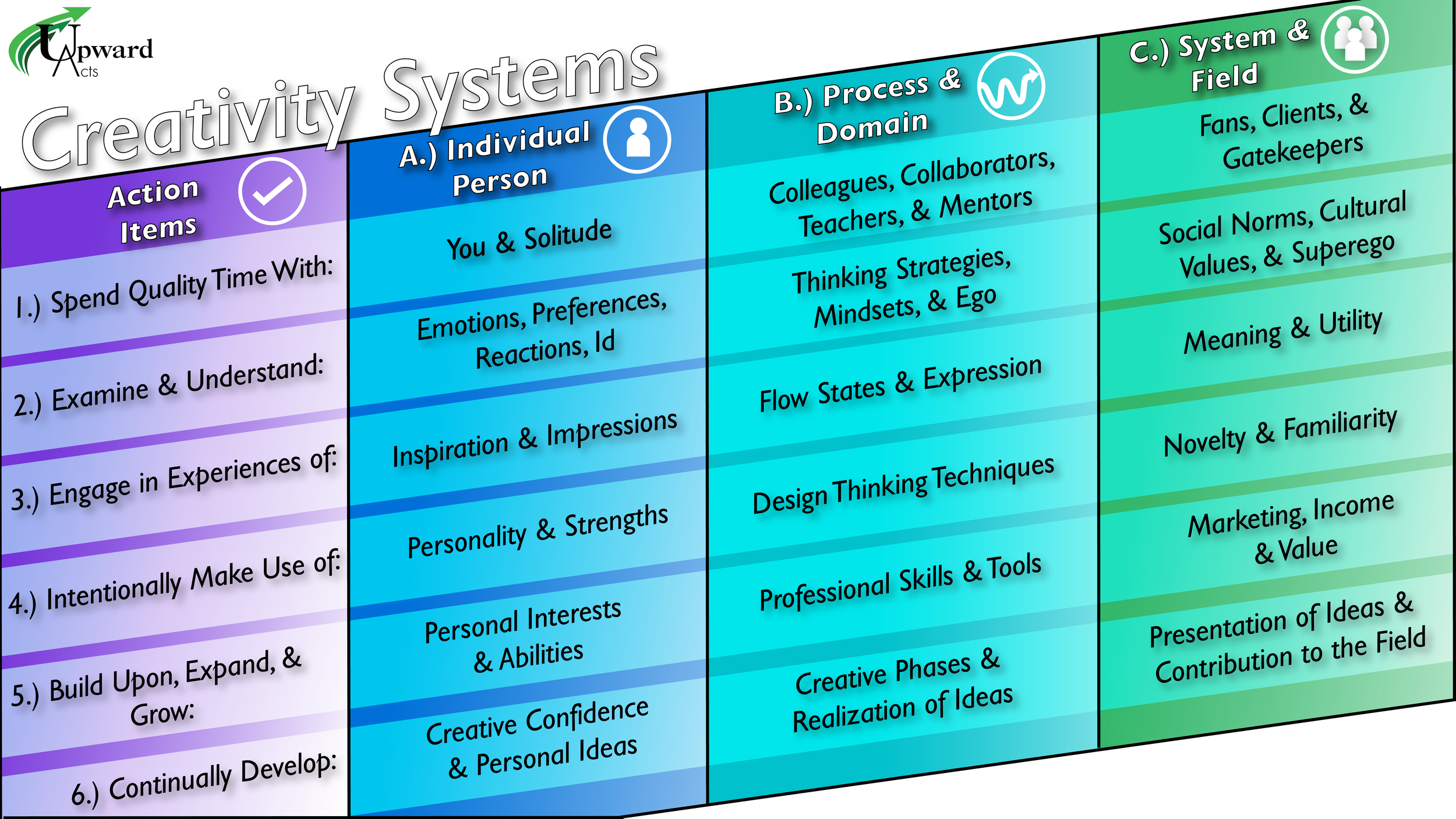Creativity Systems
Each section of the model is a facet of creativity that interacts with all the rest.
Each part is an opportunity to advance the depth of your creativity. Some will be deliberate, while others will be more spontaneous in nature. Some will rely on cognition, logic, and planning, while others will be based in emotion, intuition, and feeling. Some sections will involve a combination of thinking, feeling, deliberateness, and spontaneity. In general, you may think of deliberately setting up structures in your life that support your creativity by using planning and logic, but then letting those structures fill themselves up spontaneously based on how your intuitive feelings.
Each of the vertical columns represent distinct areas in which your creativity can flourish, however, each is also the source of various creative blocks. Working through the suggested activities in each area will invariably address any potential blocks, but in general:
if you feel blocked on the individual level it is important to recognize your anxiety and face it directly with care, curiosity, and gratitude for it’s attempt to defend you from something in your life.
If you’re feeling blocked on the performance level it is important to make sure you have realistic beliefs and mindsets about yourself and your work. If you have a reasonable understanding and you are still blocked you simply need to build up your skills with more training.
Finally, if you feel blocked on the field level you will likely suffer from a sense of meaninglessness. Here, it is important to connect your creative work with your visions and values by feeling the forces you want to be in service of and recognizing the historical and contemporary community you want to be embedded within.
Below are several suggestions for how you can begin to engage with each aspect of your creativity system. Use these as a starting point as you optimize and personalize the way your own creativity unfolds.
INDIVIDUAL * PERSON * FEELINGS * DREAMS
1A.) Go on an artist date. Choose something that feels silly, whimsical, or comforting. Imagine you’re taking your inner child out on a field trip.
2A.) Keep an emotions log. Whether on paper or on a device, simply try to notice every emotion as it arises. In the moment write down a description of the emotion and what led it to arise.
3A.) Try new foods, places, people, and ideas. Explore the world around you with special attention on how these new things make you feel.
4A.) Take a Strengths Assessment and use your unique strengths in new ways.
5A.) Make a list of the things you love and see if you can deepen anything on that list. Do the same for things you’re really good at. Don’t worry if these things aren’t directly tied to your art or career.
6A.) Make a list of your creative and professional accomplishments. Continuously create from a place of personal wonder and intrigue.
PROCESS * DOMAIN * STRUCTURE * EXPERIMENT
1B.) Begin a collaboration project
2B.) Begin a daily writing practice that involves open-ended stream of consciousness brain dumps. Use these pages to explore your beliefs and the stories you tell yourself about your experiences.
3B.) Choose your flow activity and follow the pre-requisites (Set goals, full attention, immediate feedback, challenge/skill balance, intrinsic motivation)
4B.) Learn and apply to your own work the techniques of question framing, researching, brainstorming, rapid iteration, product testing, and story sharing.
5B.) Invest in some technical classes, certifications, or equipment (Ideally those that build on your interests and skills).
6B.) Understand and reliably engage in the creative phases of Preparation, Incubation, Illumination, and Confirmation.
SYSTEM * FIELD * SUPPORT * EXHIBIT
1C.) Organize an exhibition
2C.) Visit a history museum, talk to parents & Grandparents
3C.) Connect with how your flow experiences serve something larger than yourself
4C.) Draw from the themes and styles that are already familiar to your field, and intentionally incorporate some elements that are completely new.
5C.) Identify the types of people that would benefit most from your professional skills and let them know about your work.
6C.) Share your work with colleagues and other professionals through an exhibit, conference, book, article, or presentation.
You can accomplish everything within this concept map on your own, but the support of a qualified and enthusiastic coach can ensure that you accomplish them with the right amount of support at a pace that works for you.
I've designed a new series of distinct coaching packages that will help tailor my coaching to your needs even further.
